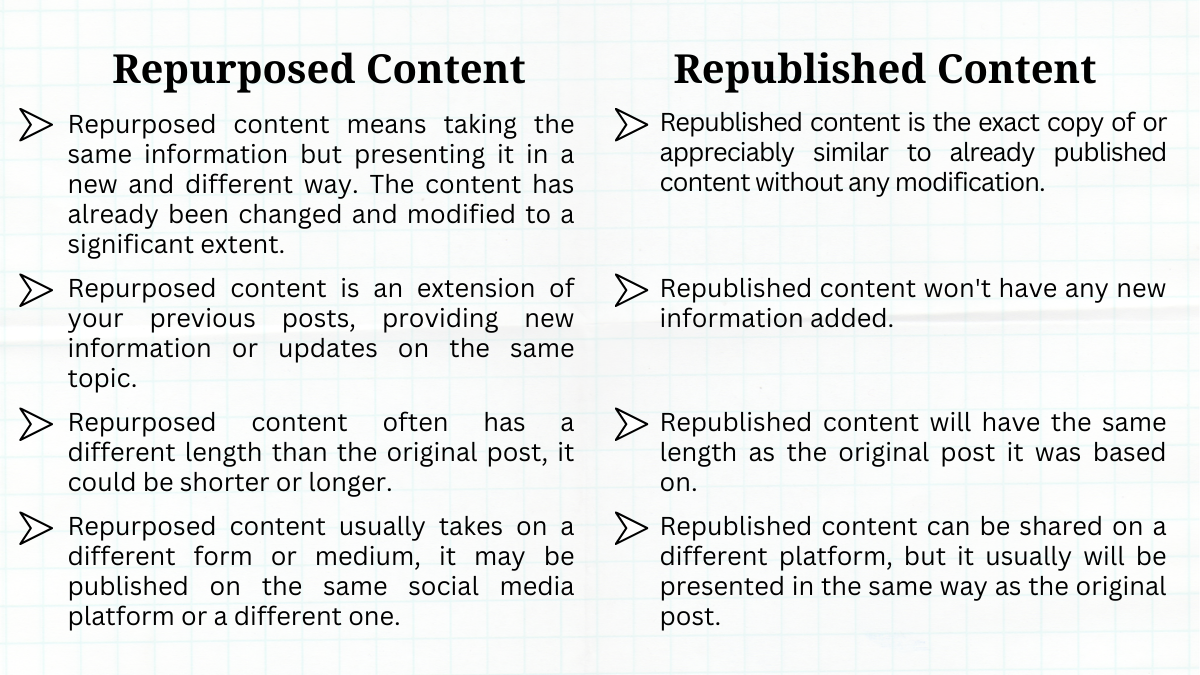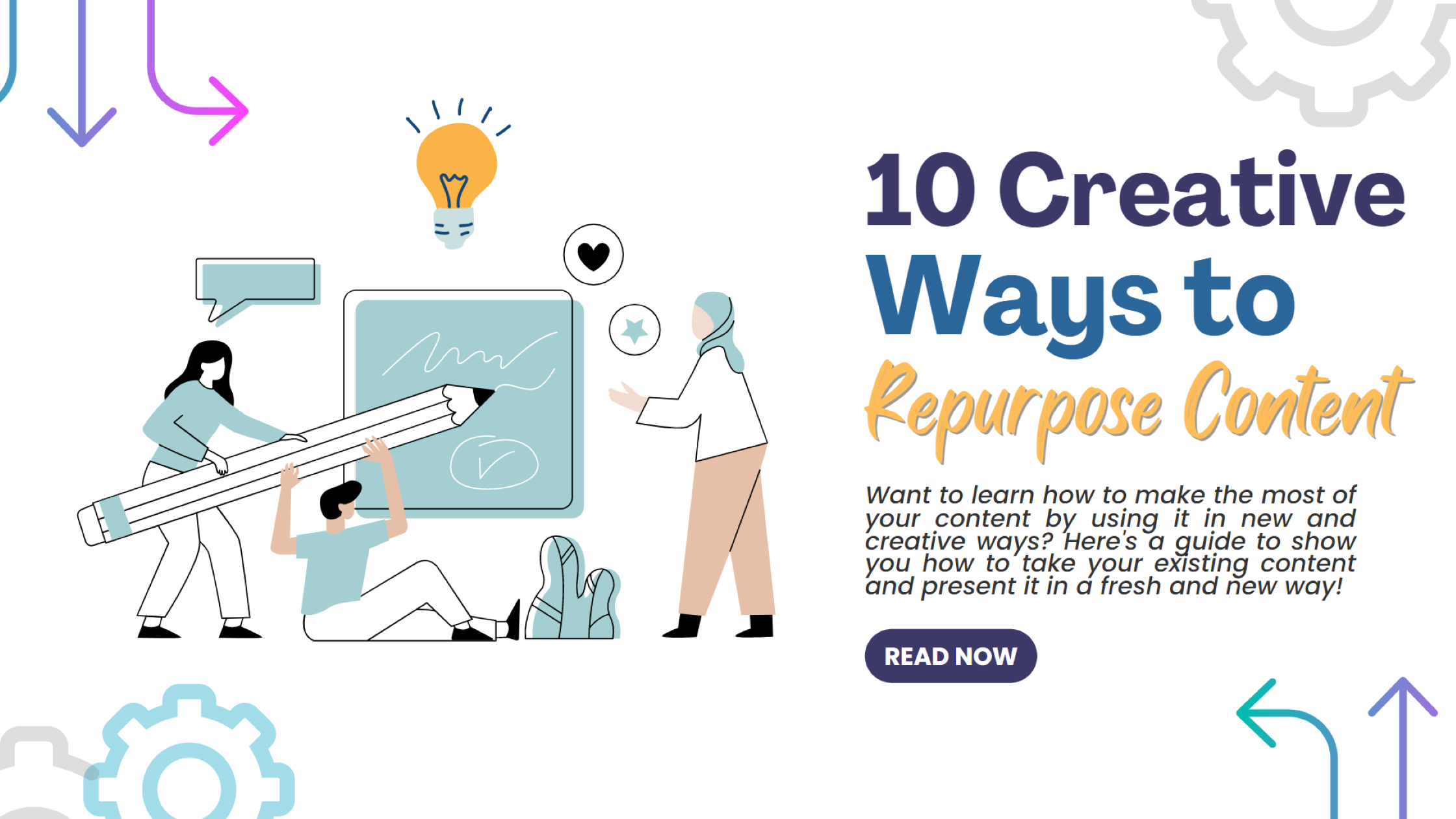To succeed in social media marketing, you must focus on creating and regularly posting good content. It’s not sufficient to create great content once in a while and then forget about your social media channels. However, if you keep posting low-quality content consistently, it won’t help you either. You need to put in a lot of effort and be creative to make your social media campaign successful, but this can be challenging.
Thankfully, content repurposing can make planning, scheduling and posting social media content much easier and more organized. Do you want to know how to reuse your content to get the most out of it? Keep reading to learn how to repurpose your content, reduce your workload, and simplify your social media campaigns.
What Is Content Repurposing?
Content repurposing means taking your existing content and modifying it to make it suitable for different types of audiences and online platforms. It’s like using the same Lego blocks to build different structures, instead of making the same thing again. The idea is to reuse the information you already have but in a new and different way.
Repurposed Content vs. Republished Content
Sometimes people confuse repurposing content with republishing it, but they are actually different things. Here is a simple table that shows the differences between the two.

What Kind of Content Can You Repurpose?
You can repurpose any content that you have created before, but you need to be smart about which ones you choose. We suggest picking evergreen content, which means information that will remain relevant for a long time. This is important because it will ensure that your social media content stays up-to-date. Choose your most successful posts and give them a new lease of life.
We advise against reusing content that has a short lifespan, but there are situations where it can still be useful. You can revisit old posts related to seasonal events to discover new trends or to refer to an interesting historical fact. However, as a general rule, it’s best to stay away from non-evergreen content.
Why Should You Perform Content Repurposing?
Repurposing your old content can bring you many benefits, besides allowing you to focus on creating new ideas. For example:
- By using the same topic in multiple posts, you can give your channel a more cohesive style.
- Repurposing content saves you time from having to come up with new ideas or research for new content.
- Sharing repurposed content on different social media platforms can help you reach a wider audience.
- Lastly, creating repurposed content in advance can provide you with backup content for busy periods.
10 Creative Ways of Content Repurposing
Repurposing content means taking your best ideas and presenting them in a fresh and exciting manner. In other words, you can recycle your content by using various techniques to attract and engage your audience. Here are some creative ways to do so:
1. Compile Content Into an eBook
Have you ever thought about creating and publishing an eBook? Writing one from scratch can be a lot of work and take up a lot of time. But, you can save time by repurposing your existing content into an eBook.
Just gather all your written work, organize it logically, add some pictures, and you’re good to go. You can even include other types of content such as videos or podcasts, but you’ll need to transcribe them first.
2. Turn an eBook Into a Course
If you have enough material to write an eBook, then you most likely have enough content to make an educational course too.
Instead of going through the trouble of converting your old blog posts into a course, it’s better to start by making an eBook. This way, it will be easier to transform your content into a course.
After that, you can make some videos explaining the material. You can even reuse some parts of your course on social media! Once you have a complete course, just upload it to your website or YouTube, and now you have your very own place for learning.
3. Create Snippets of Existing Video Content
YouTube is a very popular platform for people who want to share their videos because it has over 2.5 billion monthly active users. However, short-form video content platforms like TikTok and Instagram Reels are also rapidly growing.
The good news is that if you already have a YouTube channel, you can use your existing content to create videos for TikTok, Reels or Shorts without having to film new content.
You can also use these videos on other social media platforms like Facebook and Instagram Stories which are good for shorter videos.
4. Extract Quotes From Existing Content
If you can cut video clips into small pieces, you can do the same thing with written posts. Take out quotes from them and use them to create different kinds of content like tweets, images, and short videos.
The great thing about using quotes is that you can reuse them as evergreen content. You can even take lines from blog posts that might become outdated and turn them into timeless pieces of wisdom. You can choose how to use them however you like. You can also use a tool called a paraphrase generator to reword the text if you want.
5. Share User-Generated Content
Creating a user-generated content campaign has many benefits for your brand. It can improve your search engine ranking, increase your online presence, engage your audience, and provide you with a variety of content to use. Instagram is a great platform for sharing user-generated content, and it can help you gain more followers naturally. People trust reviews and recommendations more than branded content, so using user-generated content can be a valuable marketing tool.
6. Turn Written Content Into Podcasts (and Vice Versa)
A great way to reuse your written material is to transform it into a podcast. You can also do the opposite and change your podcast into a blog post that is informative and interesting.
This method is beneficial because it allows you to reach a wider audience by sharing your content on various channels and platforms, rather than just limiting yourself to one.
7. Turn Written Content Into Video (and Vice Versa)
If you have a blog, you could consider turning your posts into videos. And no, it doesn’t have to be just recordings of podcasts. You could make video tutorials, essays or vlogs based on your written content. Similarly, you could also turn your videos into written blog posts.
8. Create Stories From Tweets and Other Content
In 2017, Facebook, Instagram, and WhatsApp introduced Stories. Nowadays, people post over a billion Stories every day, and around two million of them are marketing-related.
Stories are a great way to engage your social media followers because they fit with their behavior. Although they can be time-consuming to create, Stories have a good track record of generating conversions.
The good news is that you can repurpose other types of content into Stories, such as tweets, screenshots of your blog, or snippets of your latest video.
9. Create Memes
Even the funniest stories or blog posts can’t compete with the popularity of catchy memes on social media and other digital platforms. You can even use memes alongside your written content. Although you can reuse memes from your previous posts, it requires a skilled content creator to make truly memorable ones.
10. Create Presentations
Although presentations may not be the most widely used type of content, it can still be beneficial to create one, particularly if you have a lot of material that can be repurposed.
By creating a presentation and making it available for download in the form of a slide deck, FAQ flipbook, or brochure promoting your business, you can reach out to a broader audience, including people who don’t spend much time on mainstream networks.
So, it’s worth considering the demographics you can target with your published presentations and showcasing your best content through them.
The Bottom Line
You don’t have to keep coming up with new ideas all the time. You already have a lot of content that you can use again! By repurposing you content, you can save time and create content that’s suitable for different audiences and platforms online.
Content repurposing can help you with your marketing efforts, whether you’re a small business owner, a new brand, or an experienced content marketer. So why not give it a try?
For more such tips, updates and learning resources, stay tuned to Insitebuild Blog.






